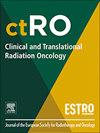Impact of tumor position displacement during end-exhalation breath-hold condition on tumor dose in lung stereotactic body radiation therapy using volumetric modulated arc therapy
IF 2.7
3区 医学
Q3 ONCOLOGY
引用次数: 0
Abstract
Background and purpose
In lung stereotactic body radiation therapy (SBRT) using a breath-holding technique, displacement of tumor during breath-holding is rarely considered. This study used four-dimensional (4D) dose calculation with cine computed tomography (CT) to evaluate the impact of unexpected tumor position displacement during breath-holding on the target dose of lung volumetric modulated arc therapy (VMAT)-SBRT.
Materials and methods
This study included 20 cases for which tumor position displacement during end-exhalation breath-holding (range: 0.5–12.6 mm) was evaluated on cine CT. VMAT-SBRT plans (3D dose) were generated using treatment planning CT images (reference CT) acquired during end-exhalation breath-hold. For each plan, the 4D dose was calculated using deformable image registration of the cine CT images and was accumulated onto the reference CT. Dose metrics and the mean biologically effective dose at = 10 (BED10) for the gross tumor volume (GTV) were compared between 3D and 4D doses.
Results
In the 17 cases where the tumor was within the planning target volume (PTV) during breath-holding, the difference between the 3D and 4D doses was within 3 % for each dose metric. However, in 3 cases where the tumor position during breath-holding included displacement outside the PTV, both the D98% and mean BED10 of the GTV were reduced by 6.9–20.0 % and 2.1–13.8 %, respectively, in 4D doses compared to 3D doses.
Conclusion
Our study showed that tumor position displacements during breath-holding may lead to substantial tumor dose reduction.
呼气末屏气条件下肿瘤位置移位对肺立体定向体放射治疗中肿瘤剂量的影响。
背景与目的:在采用屏气技术的肺立体定向放射治疗(SBRT)中,很少考虑屏气过程中肿瘤的移位。本研究采用电影计算机断层扫描(CT)的四维(4D)剂量计算来评估屏气期间意外肿瘤位置移位对肺体积调节电弧治疗(VMAT)-SBRT靶剂量的影响。材料与方法:选取20例呼气末屏气时肿瘤位置移位(范围:0.5 ~ 12.6 mm)在CT上进行评估。使用呼气末屏气时获得的治疗计划CT图像(参考CT)生成VMAT-SBRT计划(3D剂量)。对于每个方案,使用电影CT图像的可变形图像配准计算4D剂量,并累积到参考CT上。比较3D和4D剂量的剂量指标和α / β = 10时的平均生物有效剂量(BED10)与总肿瘤体积(GTV)。结果:屏气时肿瘤在计划靶体积(PTV)内的17例,各剂量指标的3D和4D剂量差异在3%以内。然而,在3例屏气时肿瘤位置包括PTV外移位的病例中,与3D剂量相比,4D剂量下GTV的D98%和平均BED10分别降低了6.9- 20.0%和2.1- 13.8%。结论:我们的研究表明,在屏气过程中肿瘤位置的移位可能导致肿瘤剂量的显著减少。
本文章由计算机程序翻译,如有差异,请以英文原文为准。
求助全文
约1分钟内获得全文
求助全文
来源期刊

Clinical and Translational Radiation Oncology
Medicine-Radiology, Nuclear Medicine and Imaging
CiteScore
5.30
自引率
3.20%
发文量
114
审稿时长
40 days
 求助内容:
求助内容: 应助结果提醒方式:
应助结果提醒方式:


